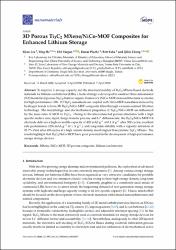| dc.contributor.author | Liu, Yijun | |
| dc.contributor.author | He, Ying | |
| dc.contributor.author | Vargün, Elif | |
| dc.contributor.author | Plachy, Tomas | |
| dc.contributor.author | Saha, Petr | |
| dc.contributor.author | Cheng, Qilin | |
| dc.date.accessioned | 2020-11-20T14:39:38Z | |
| dc.date.available | 2020-11-20T14:39:38Z | |
| dc.date.issued | 2020 | |
| dc.identifier.issn | 2079-4991 | |
| dc.identifier.uri | https://doi.org/10.3390/nano10040695 | |
| dc.identifier.uri | https://hdl.handle.net/20.500.12809/522 | |
| dc.description | WOS: 000539577200098 | en_US |
| dc.description | PubMed ID: 32272560 | en_US |
| dc.description.abstract | To improve Li storage capacity and the structural stability of Ti3C2 MXene-based electrode materials for lithium-ion batteries (LIBs), a facile strategy is developed to construct three-dimensional (3D) hierarchical porous Ti3C2/bimetal-organic framework (NiCo-MOF) nanoarchitectures as anodes for high-performance LIBs. 2D Ti3C2 nanosheets are coupled with NiCo-MOF nanoflakes induced by hydrogen bonds to form 3D Ti3C2/NiCo-MOF composite films through vacuum-assisted filtration technology. The morphology and electrochemical properties of Ti3C2/NiCo-MOF are influenced by the mass ratio of MOF to Ti3C2. Owing to the interconnected porous structures with a high specific surface area, rapid charge transfer process, and Li+ diffusion rate, the Ti3C2/NiCo-MOF-0.4 electrode delivers a high reversible capacity of 402 mAh g(-1)-at 0.1 A g(-1)-after 300 cycles; excellent rate performance (256 mAh g(-1)-at 1 A g(-1)); and long-term stability with a capacity retention of 85.7% eVen after 400 cycles at a high current density, much higher than pristine Ti3C2 MXene. The results highlight that Ti3C2/NiCo-MOF have great potential in the development of high-performance energy storage devices. | en_US |
| dc.description.sponsorship | National Natural Science Foundation of ChinaNational Natural Science Foundation of China (NSFC) [51702098]; National Key R&D Program of China [2016YFE0131200]; International Cooperation Project of Shanghai Municipal Science and Technology Committee [18520744400] | en_US |
| dc.description.sponsorship | This work was supported by the National Natural Science Foundation of China (51702098); the National Key R&D Program of China (2016YFE0131200); and the International Cooperation Project of Shanghai Municipal Science and Technology Committee (18520744400). | en_US |
| dc.item-language.iso | eng | en_US |
| dc.publisher | Mdpi | en_US |
| dc.item-rights | info:eu-repo/semantics/openAccess | en_US |
| dc.subject | Mxene | en_US |
| dc.subject | Nico-MOF | en_US |
| dc.subject | 3D Porous Composite | en_US |
| dc.subject | Lithium Ion Batteries | en_US |
| dc.title | 3D Porous Ti3C2 MXene/NiCo-MOF Composites for Enhanced Lithium Storage | en_US |
| dc.item-type | article | en_US |
| dc.contributor.department | MÜ, Fen Fakültesi, Kimya Bölümü | en_US |
| dc.contributor.institutionauthor | Vargün, Elif | |
| dc.identifier.doi | 10.3390/nano10040695 | |
| dc.identifier.volume | 10 | en_US |
| dc.identifier.issue | 4 | en_US |
| dc.relation.journal | Nanomaterials | en_US |
| dc.relation.publicationcategory | Makale - Uluslararası Hakemli Dergi - Kurum Öğretim Elemanı | en_US |


















